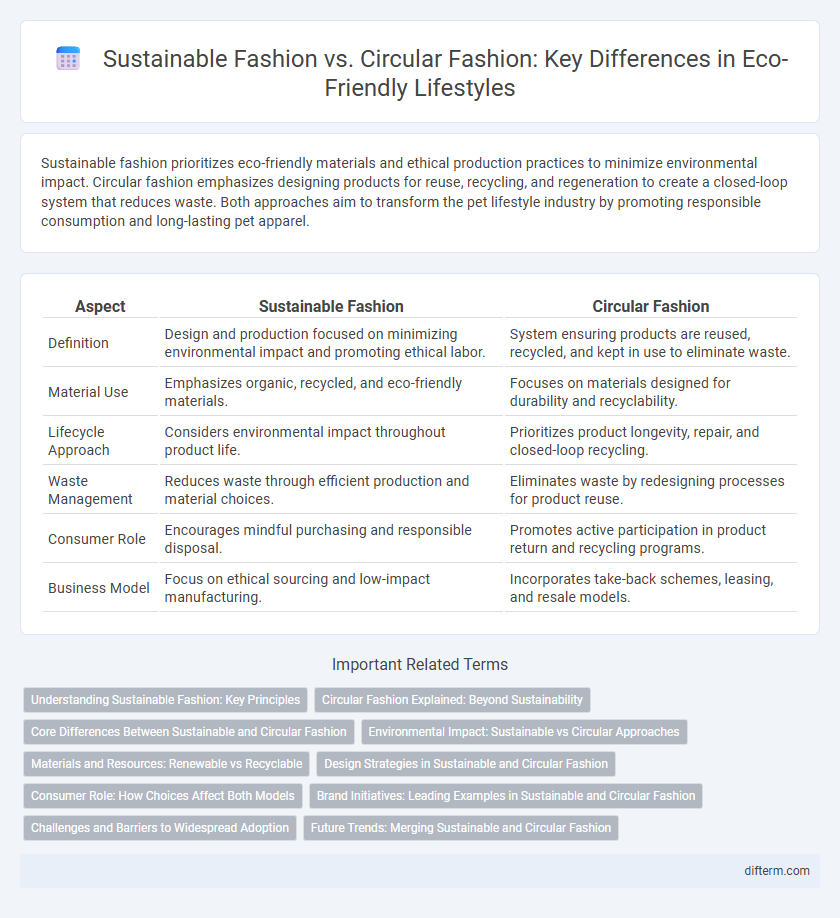Sustainable fashion prioritizes eco-friendly materials and ethical production practices to minimize environmental impact. Circular fashion emphasizes designing products for reuse, recycling, and regeneration to create a closed-loop system that reduces waste. Both approaches aim to transform the pet lifestyle industry by promoting responsible consumption and long-lasting pet apparel.
Table of Comparison
| Aspect | Sustainable Fashion | Circular Fashion |
|---|---|---|
| Definition | Design and production focused on minimizing environmental impact and promoting ethical labor. | System ensuring products are reused, recycled, and kept in use to eliminate waste. |
| Material Use | Emphasizes organic, recycled, and eco-friendly materials. | Focuses on materials designed for durability and recyclability. |
| Lifecycle Approach | Considers environmental impact throughout product life. | Prioritizes product longevity, repair, and closed-loop recycling. |
| Waste Management | Reduces waste through efficient production and material choices. | Eliminates waste by redesigning processes for product reuse. |
| Consumer Role | Encourages mindful purchasing and responsible disposal. | Promotes active participation in product return and recycling programs. |
| Business Model | Focus on ethical sourcing and low-impact manufacturing. | Incorporates take-back schemes, leasing, and resale models. |
Understanding Sustainable Fashion: Key Principles
Sustainable fashion prioritizes eco-friendly materials, ethical production processes, and reducing environmental impact by minimizing waste and pollution. It emphasizes transparency in supply chains and fair labor practices to ensure social responsibility throughout the garment lifecycle. Embracing these principles supports long-term environmental health and equitable industry standards.
Circular Fashion Explained: Beyond Sustainability
Circular fashion redefines the apparel industry by emphasizing closed-loop production processes that minimize waste through recycling, upcycling, and designing for longevity. Unlike general sustainable fashion, which focuses on reducing environmental impact, circular fashion aims to create a regenerative system where garments continuously re-enter the supply chain. This approach not only conserves resources but also fosters innovation in materials and manufacturing techniques to extend product life cycles.
Core Differences Between Sustainable and Circular Fashion
Sustainable fashion emphasizes reducing environmental impact through ethical sourcing, eco-friendly materials, and fair labor practices, aiming to minimize waste from production to consumption. Circular fashion focuses explicitly on designing products for longevity, reuse, and recycling, creating closed-loop systems that keep garments in use and out of landfills. The core difference lies in sustainable fashion's broad environmental and social goals, whereas circular fashion targets resource efficiency and waste elimination within the fashion lifecycle.
Environmental Impact: Sustainable vs Circular Approaches
Sustainable fashion emphasizes reducing environmental harm through eco-friendly materials and ethical production, minimizing waste and carbon emissions throughout the supply chain. Circular fashion advances this approach by designing products for reuse, repair, and recycling, aiming to create a closed-loop system that eliminates textile waste and reduces resource extraction. Circular methods demonstrate greater potential for long-term environmental impact reduction by promoting product life extension and material regeneration.
Materials and Resources: Renewable vs Recyclable
Sustainable fashion emphasizes the use of renewable materials such as organic cotton, hemp, and bamboo, which can be regrown with minimal environmental impact. Circular fashion prioritizes recyclable materials like nylon, polyester, and metal-based components that can be recovered and reprocessed into new products, reducing waste. Both approaches aim to optimize resource efficiency, but sustainable fashion focuses on natural renewability, while circular fashion centers on material recovery and reuse.
Design Strategies in Sustainable and Circular Fashion
Sustainable fashion design strategies emphasize the use of eco-friendly materials, minimizing waste, and reducing carbon footprints through responsible sourcing and production techniques. Circular fashion design focuses on creating garments for longevity, easy repair, and recyclability, incorporating modular design and closed-loop systems. Both approaches prioritize resource efficiency but circular fashion specifically integrates end-of-life garment recovery to maintain material value within the fashion ecosystem.
Consumer Role: How Choices Affect Both Models
Consumer preferences drive the adoption of sustainable fashion by favoring ethically produced, eco-friendly materials that reduce environmental impact. In contrast, circular fashion relies heavily on consumers' participation in practices like recycling, repairing, and reselling garments to extend product lifecycles and minimize waste. The collective commitment of shoppers to conscious buying directly influences the success and scalability of both sustainable and circular fashion models.
Brand Initiatives: Leading Examples in Sustainable and Circular Fashion
Patagonia exemplifies sustainable fashion by integrating eco-friendly materials and transparent supply chains to reduce environmental impact. Eileen Fisher leads circular fashion through its Renew program, which repairs, resells, and recycles garments to extend product life cycles. Stella McCartney pioneers both approaches by adopting sustainable sourcing and circular design principles to minimize waste and promote responsible consumption.
Challenges and Barriers to Widespread Adoption
Sustainable fashion faces challenges such as limited consumer awareness, higher production costs, and inadequate supply chain transparency. Circular fashion struggles with barriers including the complexity of designing for recyclability, lack of standardized recycling infrastructure, and difficulties in scaling closed-loop systems. Both approaches require significant industry collaboration and regulatory support to overcome these obstacles and achieve widespread adoption.
Future Trends: Merging Sustainable and Circular Fashion
Future trends in fashion emphasize the integration of sustainable and circular approaches to reduce environmental impact and resource consumption. Innovations like bio-based materials, zero-waste design, and advanced recycling technologies drive the evolution toward a closed-loop system. Brands adopting regenerative agriculture and digital fashion further accelerate the shift to more responsible, eco-friendly fashion practices.
Sustainable Fashion vs Circular Fashion Infographic

 difterm.com
difterm.com